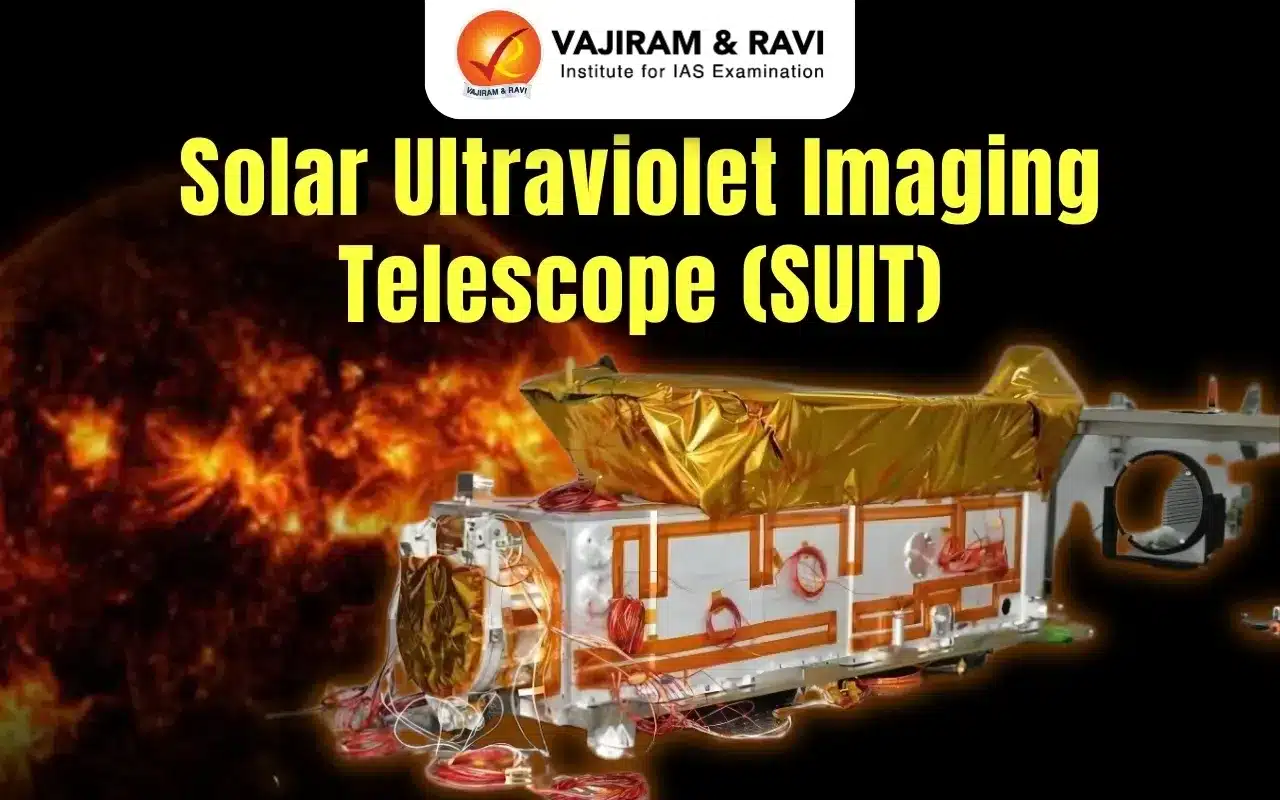Solar Ultraviolet Imaging Telescope Latest News
The Solar Ultraviolet Imaging Telescope (SUIT) instrument onboard Aditya-L1 observed an X6.3-class solar flare recently, one of the most intense categories of solar eruptions.
About Solar Ultraviolet Imaging Telescope
- It is one of the remote sensing payloads on board the Aditya-L1, the first dedicated solar mission of the Indian Space Research Organization (ISRO), that was launched on September 02, 2023.
- It was developed by Pune’s Inter-University Center for Astronomy and Astrophysics (IUCAA) in close collaboration with various ISRO Centres.
- SUIT is designed to provide near-simultaneous full-disk and region-of-interest images of the Sun at various heights, slicing through the photosphere and chromosphere.
- It employs an array of 11 scientifically calibrated filters (3 broad-band & 8 narrow-band) strategically positioned within the wavelength range of 200 to 400 nanometers.
- Located at the first Lagrange point, SUIT observes the Sun 24×7, without any interruption.
- The primary scientific objective of SUIT is to scrutinize the dynamic interplay within the magnetized solar atmosphere, delving into the intricacies of energetic phenomena such as jets, flares, filament evolution, and eruptions.
- Furthermore, SUIT, for the first time ever, will help scientists to measure and monitor the spatially resolved solar spectral irradiance within the wavelength range crucial to comprehend the intricacies of the sun-climate relationship.
What is a Solar Flare?
- A solar flare is a sudden and intense burst of solar energy from the Solar atmosphere.
- Flares are our solar system’s largest explosive events.
- They are seen as bright areas in the sun, and they can last from minutes to hours.
- The phenomenon is caused by the Sun’s magnetic field.
- The magnetic field of the Sun is very dynamic in nature.
- Sometimes they suddenly snap and release intense bursts of energy – like a powerful, short flash.
- The energy is released in the form of light/radiation and high energy charged particles.
- Although solar flares can be visible in white light, they are often more readily noticed via their bright X-ray and ultraviolet emissions.
- Effect of Solar Flare on Earth:
- The intense radiation emitted during a solar flare can affect satellite communications, disrupt radio signals, and even pose a risk to astronauts in space.
- Additionally, the increased solar radiation can lead to geomagnetic storms, which may impact power grids and cause auroras (northern and southern lights) at lower latitudes.
Solar Ultraviolet Imaging Telescope FAQs
Q1. Who made the SUIT telescope?
Ans. It was developed by Pune’s Inter-University Center for Astronomy and Astrophysics (IUCAA).
Q2. How much did Aditya-L1 cost?
Ans. 3.78 billion Indian rupees ($45.5 million)
Q3. What is the main purpose of Aditya-L1?
Ans. The main purpose of Aditya-L1 is to study the Sun, particularly its outermost layers, and understand its impact on space weather.
Source: IE
Last updated on December, 2025
→ Check out the latest UPSC Syllabus 2026 here.
→ Join Vajiram & Ravi’s Interview Guidance Programme for expert help to crack your final UPSC stage.
→ UPSC Mains Result 2025 is now out.
→ UPSC Notification 2026 is scheduled to be released on January 14, 2026.
→ UPSC Calendar 2026 is released on 15th May, 2025.
→ The UPSC Vacancy 2025 were released 1129, out of which 979 were for UPSC CSE and remaining 150 are for UPSC IFoS.
→ UPSC Prelims 2026 will be conducted on 24th May, 2026 & UPSC Mains 2026 will be conducted on 21st August 2026.
→ The UPSC Selection Process is of 3 stages-Prelims, Mains and Interview.
→ UPSC Result 2024 is released with latest UPSC Marksheet 2024. Check Now!
→ UPSC Prelims Result 2025 is out now for the CSE held on 25 May 2025.
→ UPSC Toppers List 2024 is released now. Shakti Dubey is UPSC AIR 1 2024 Topper.
→ UPSC Prelims Question Paper 2025 and Unofficial Prelims Answer Key 2025 are available now.
→ UPSC Mains Question Paper 2025 is out for Essay, GS 1, 2, 3 & GS 4.
→ UPSC Mains Indian Language Question Paper 2025 is now out.
→ UPSC Mains Optional Question Paper 2025 is now out.
→ Also check Best IAS Coaching in Delhi

















